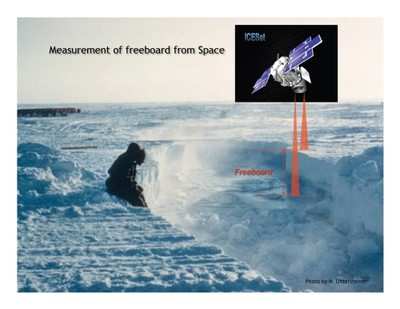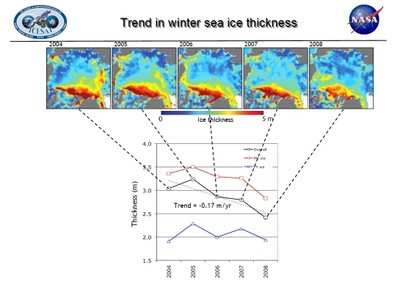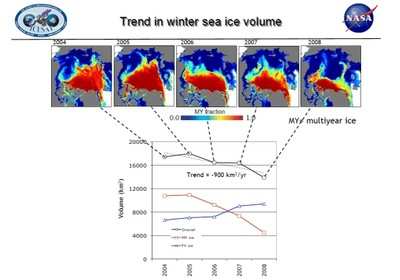Ice Thinned Just Over Two Feet In Four Winters
 Arctic sea ice thinned dramatically between the winters of
2004 and 2008, with thin seasonal ice replacing thick older ice as
the dominant type for the first time on record. The new results,
based on data from a NASA Earth-orbiting spacecraft, provide
further evidence for the ongoing transformation of the Arctic's ice
cover.
Arctic sea ice thinned dramatically between the winters of
2004 and 2008, with thin seasonal ice replacing thick older ice as
the dominant type for the first time on record. The new results,
based on data from a NASA Earth-orbiting spacecraft, provide
further evidence for the ongoing transformation of the Arctic's ice
cover.
Scientists from NASA and the University of Washington in Seattle
conducted the most comprehensive survey to date using observations
from NASA's Ice, Cloud and land Elevation Satellite, known as
ICESat, to make the first basin-wide estimate of the thickness and
volume of the Arctic Ocean's ice cover. Ron Kwok of NASA's Jet
Propulsion Laboratory in Pasadena, Calif., led the research team,
which published its findings July 7 in the Journal of Geophysical
Research-Oceans.
The Arctic ice cap grows each winter as the sun sets for several
months and intense cold ensues. In the summer, wind and ocean
currents cause some of the ice naturally to flow out of the Arctic,
while much of it melts in place. But not all of the Arctic ice
melts each summer; the thicker, older ice is more likely to
survive. Seasonal sea ice usually reaches about 2 meters (6 feet)
in thickness, while multi-year ice averages 3 meters (9 feet).

Using ICESat measurements, scientists found that overall Arctic
sea ice thinned about 0.17 meters (7 inches) a year, for a total of
0.68 meters (2.2 feet) over four winters. The total area covered by
the thicker, older "multi-year" ice that has survived one or more
summers shrank by 42 percent.
Previously, scientists relied only on measurements of area to
determine how much of the Arctic Ocean is covered in ice, but
ICESat makes it possible to monitor ice thickness and volume
changes over the entire Arctic Ocean for the first time. The
results give scientists a better understanding of the regional
distribution of ice and provide better insight into what is
happening in the Arctic.

"Ice volume allows us to calculate annual ice production and
gives us an inventory of the freshwater and total ice mass stored
in Arctic sea ice," said Kwok. "Even in years when the overall
extent of sea ice remains stable or grows slightly, the thickness
and volume of the ice cover is continuing to decline, making the
ice more vulnerable to continued shrinkage. Our data will help
scientists better understand how fast the volume of Arctic ice is
decreasing and how soon we might see a nearly ice-free Arctic in
the summer."
In recent years, the amount of ice replaced in the winter has
not been sufficient to offset summer ice losses. The result is more
open water in summer, which then absorbs more heat, warming the
ocean and further melting the ice. Between 2004 and 2008,
multi-year ice cover shrank 1.54 million square kilometers (595,000
square miles) -- nearly the size of Alaska's land area.

The research team attributes the changes in the overall
thickness and volume of Arctic Ocean sea ice to the recent warming
and anomalies in patterns of sea ice circulation.
"The near-zero replenishment of the multi-year ice cover, combined
with unusual exports of ice out of the Arctic after the summers of
2005 and 2007, have both played significant roles in the loss of
Arctic sea ice volume over the ICESat record," said Kwok
 ANN's Daily Aero-Term (04.25.24): Airport Rotating Beacon
ANN's Daily Aero-Term (04.25.24): Airport Rotating Beacon ANN's Daily Aero-Linx (04.25.24)
ANN's Daily Aero-Linx (04.25.24) Klyde Morris (04.22.24)
Klyde Morris (04.22.24) Airborne 04.24.24: INTEGRAL E, Elixir USA, M700 RVSM
Airborne 04.24.24: INTEGRAL E, Elixir USA, M700 RVSM Airborne 04.22.24: Rotor X Worsens, Airport Fees 4 FNB?, USMC Drone Pilot
Airborne 04.22.24: Rotor X Worsens, Airport Fees 4 FNB?, USMC Drone Pilot






